镜头成像
在光学中,光线是光的几何表示,通过选择一条垂直于实际光的波前并指向能量流方向的曲线来理想化。光线用于表示光通过光学系统的传播,方法是将真实的光场分离成离散的光线,这些光线可以使用光线追踪技术通过系统进行计算。这使得以数学方式研究或模拟最复杂的光学系统成为可能。光线追踪基于麦克斯韦方程的近似解,只要光波流过尺寸明显大于光波长的物体并在其周围流动,该方程就成立。例如,衍射需要研究波动光学,而射线或几何光学无法解决这一问题。向射线模型添加相位可用于描述波现象,例如在某些情况下的干涉。
什么是镜头?
Light beams flow through lenses, which are optical devices that allow light to pass through them. A lens is a transparent substance constrained by two curved surfaces that can refract light rays. A lens can have one surface plane and another spherical surface, indicating that it has at least one.
镜片通常由一块薄玻璃或塑料制成。双筒望远镜、望远镜、视力矫正眼镜、手电筒和显微镜只是其中的几个例子。
镜头类型
根据光线是会聚还是发散,有两种类型的透镜。有两种类型的镜头:
- 凸透镜(会聚透镜)
- 凹透镜(发散透镜)
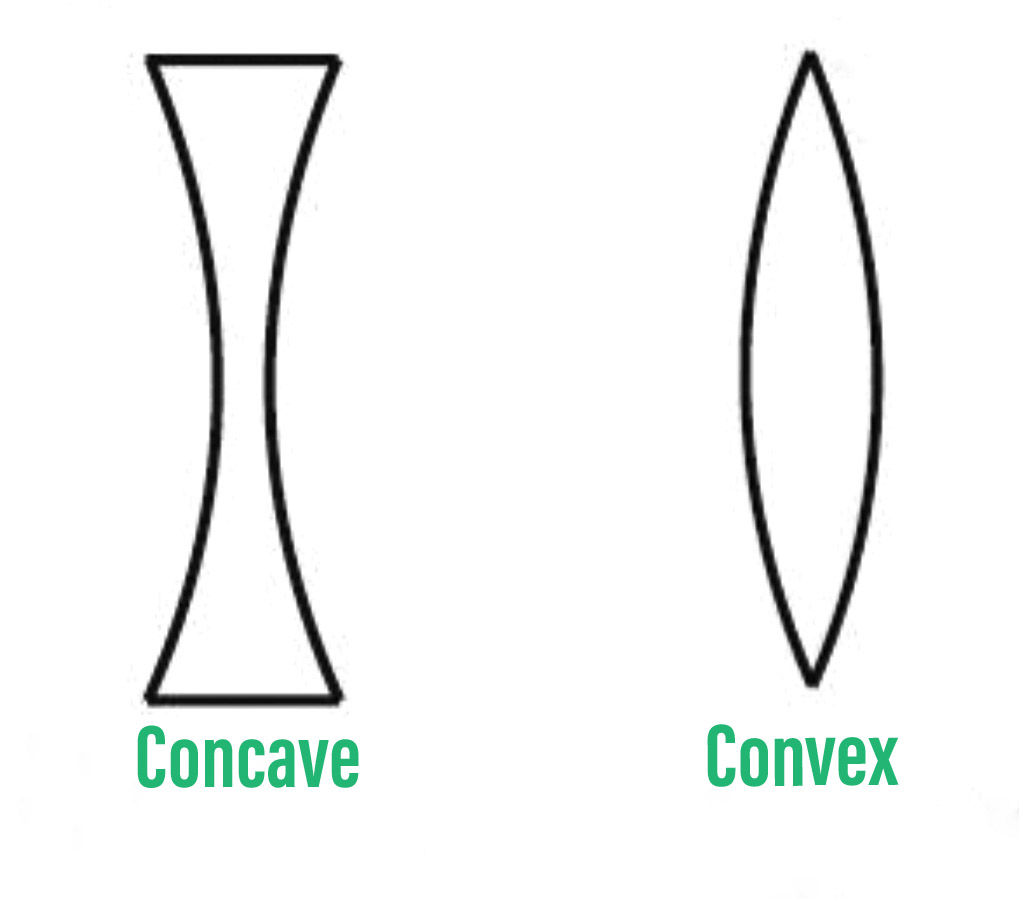
镜头类型
凸透镜
The spherical surfaces of a convex lens bulge out in the middle. The middle of a convex lens is thicker than the edges, while the margins are thinner. The parallel beams of light falling on its surface are converged by this lens. As a result, a convex lens can also be referred to as a converging lens. Depending on the object’s distance from the lens, this lens can create both actual and virtual images.

会聚透镜
凹透镜
A concave lens has an inwardly curved spherical surface. The middle of a concave lens is thinner, while the edges are thicker. Parallel beams of light falling on the surface of a concave lens diverge. As a result, a diverging lens is also known as a concave lens. Regardless of the object’s distance from the lens, this lens creates a virtual and erect image of it.
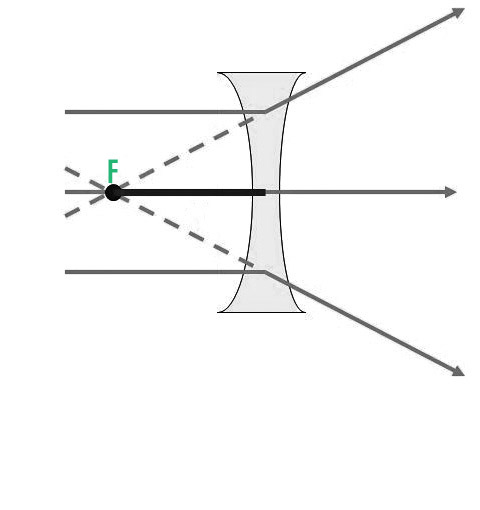
发散透镜
与镜头相关的术语
- 曲率中心:凸透镜或凹透镜的每个表面都是一个球体的组成部分,它是曲率中心。由字母 C 表示的曲率中心是该球体的中心。镜片有两个曲率中心,用字母 C 1和 C 2表示。
- 主轴:镜片的主轴是一条穿过镜片曲率中心的假想线。
- 光学中心:穿过透镜光学中心的光线永远不会偏离其路径。镜片的光学中心在镜片的中间。它由字母 O 表示。
- 镜头孔径:镜头的孔径是镜头圆形轮廓的有效直径。
- 曲率半径:从中提取透镜的球体的半径称为透镜的半径。透镜的曲率半径由R 1和R 2表示。
- 主焦点:对于凸透镜,它是所有平行光束在折射后相遇的点,对于凹透镜,它是所有平行光束在折射后看起来发散的点。
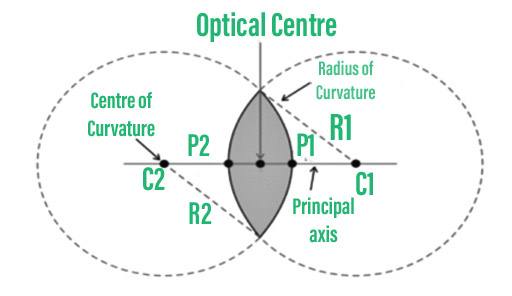
凹凸透镜成像
图像的显影是由镜头对光的折射引起的。射线图可以描述图像的生成以及由镜头创建的图像的性质和位置。我们可以通过使用光线追踪路径来制作光线图。至少有两条这样的光线必须从物体发出并穿过透镜。
图像的位置由从物体发出的光线在折射后相遇或似乎相遇的点确定。
要设计射线图,我们必须遵循一定的规则:
- 经凸透镜折射后,平行于主轴的光束通过焦点。凹透镜看起来远离应力,这样当发散光线延伸时,它将在焦点处相遇。
- 穿过光学中心的光线不会偏离。
- 穿过凸透镜焦点的光线在折射后平行于主轴移动。在凹透镜的情况下,光线似乎在折射移动平行于主轴之后的方向上相遇。
凸透镜成像
- 当物体 (AB) 保持在无限远时,落在凸透镜上的光线似乎平行于主轴。结果,在折射之后,所有这些光线都在主焦点处发生碰撞。这会导致逼真的颠倒和大大降低的图像。
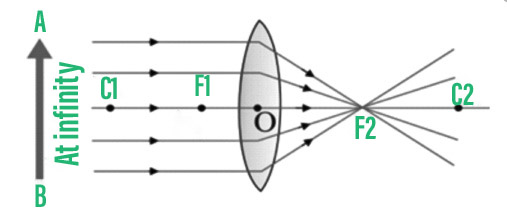
无限远的物体
- 当物品 (AB) 保持在曲率中心时,图像 (A'B') 在曲率中心处镜头的相对侧获得。该图像将是真实的和倒置的,并且与事物的大小相同。
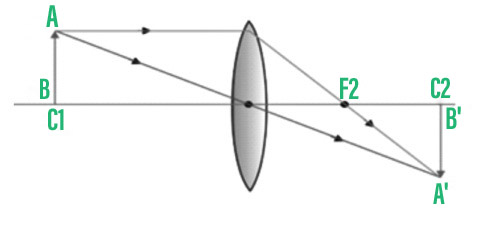
C 1处的对象
- 当物体 (AB) 保持在凸透镜的焦点和光学中心之间时,所获得的图像 (A'B') 与物体位于镜头的同一侧。它将是倒置的、夸张的和虚拟的。
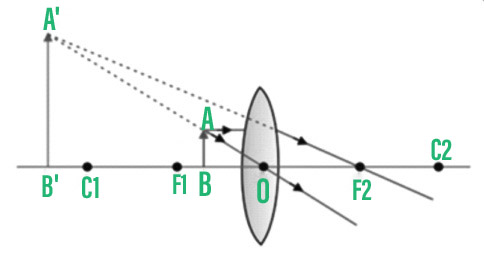
F 1和 O 之间的对象
凹透镜成像
- 当物体在凹透镜前保持在无限远时获得的图像是在透镜的焦点处获得的。此图像将大大缩小,虚拟和直立。
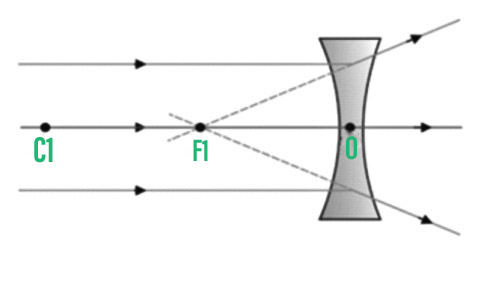
无限远的物体
- 当物体(AB)位于无限远和凹透镜的光学中心之间时,图像(A'B')将在焦点和光学中心之间形成。图像将被缩小、模拟和直立。
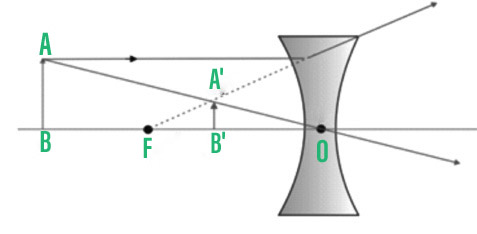
超出 F 的对象
镜头的签名约定
The optical center is used as the origin, and the primary axis is used as the X-axis, according to sign convention. The following are the convention’s rules:
- The item is always positioned to the left of the optical center or lens.
- The optical center is used to measure all distances parallel to the major axis.
- Positive values are assigned to any distances measured to the right of the optical center or origin.
- All distances to the left of the optical center or origin are considered negative.
- Positive values are assigned to vertical distances measured above the primary axis.
- Negative values are assigned to vertical distances measured below the primary axis.
For example, a concave lens has a negative focal length while a convex lens has a positive focal length.
镜片配方
可以使用镜头公式和关于物距和焦距的信息来计算像距。镜头公式描述了光学中图像距离 (v)、物体距离 (u) 和镜头焦距 (f) 之间的关系。透镜公式适用于凸透镜和凹透镜。这些镜片的厚度很小。对于球面镜,它是一个连接焦距、像距和物距的方程。写成,
1/f = 1/v-1/u
where,
- v is the distance of the image from the lens,
- u is the distance of the object from the lens, and
- f is the focal length of the lens.
通过适当的符号约定,可以在任何情况下使用透镜公式。该镜片配方适用于凹透镜和凸透镜。如果等式产生负像距,则图像是与物体位于镜头同一侧的虚拟图像。如果该等式中的焦距为负,则该透镜是发散透镜而不是会聚透镜。该等式可用于计算实际图片和虚拟图片之间的距离。
镜头的放大倍率
图像高度与物体高度之比定义为镜头的放大倍率。它也以图片和物距的形式表示。它等于图片距离除以物距。
m = hi/ho = v/u
where,
- m is the magnification of the lens,
- hi is the height of image, and
- ho is the height of an object.
镜头的用途
根据不同镜头创建的图像类型,我们可以在各种应用中使用镜头。当非常靠近物品时,凸透镜会产生一个虚拟的、直立的、高度放大的图像。作为放大镜,它可以在需要更宽视野的情况下使用,而凹透镜会不断产生虚拟和缩小的图像。
凸透镜的用途
- 远视使用凸透镜治疗。
- 在投影仪和显微镜中,使用凸透镜。
- 耳鼻喉科医生利用凸透镜获得物体的放大视图。
凹透镜的用途
- 近视用凹透镜矫正。
- 室内的窥视孔有一个凹透镜。
- 在激光器中,使用凹透镜来扩展光束。
示例问题
问题1:究竟什么是镜头?
回答:
A lens is an optical device that allows light rays to pass through it. The lens is a transparent material that may refract light rays and is bordered by two curved surfaces.
问题2:镜片的种类有哪些?
回答:
Lenses are classified as either convergent or divergent depending on their ability to converge or diverge light beams. There are two types of lenses: convex and concave. A concave lens can diverge light rays, whereas a convex lens may converge them.
问题三:凹透镜有什么用途?
回答:
Following are the uses of concave lenses:
- A concave lens is used to treat myopia.
- A concave lens is used in door peepholes.
- A concave lens is used in lasers to broaden the beam.
问题4:符号约定是什么?
回答:
According to sign convention, the optical centre is utilised as the origin, and the main axis is used as the X-axis. The convention’s rules are as follows:
- The object is always on the left side of the optical centre or lens.
- All distances parallel to the main axis are measured using the optical centre.
- Any distances measured to the right of the optical centre or origin are given positive values.
- Negative distances are those to the left of the optical centre or origin.
- Vertical distances recorded above the primary axis are given positive values.
- Vertical distances measured below the major axis are given negative values.
问题5:焦距为30cm的平凸透镜水平面已镀银。在凸面,将物品放置在距镜片 40 厘米的位置。什么是像距?
回答:
We know that,
1/v-1/u=1/f
1/v=1/30-1/40
1/v=4-3/120
v=+120 cm
Now, this image acts as an object for the lens
So, u=+120 cm , f=30 cm
1/v-1/u=1-f
1/v=1/30+1/120
v=+24 cm
问题 6:焦距为 30 cm 的会聚透镜和焦距为 20 cm 的发散透镜的主轴相距 15 cm。物体应该放在哪里才能形成无限的图像?
回答:
Two cases are possible.
Case 1:
Final image is formed by the concave lens.
For concave lens v=∞; f=−20 cm
u=+20 cm
Now, v=20+15=35 cm serves as image distance for the convex lens.
So, v=+35 cm; f=+30 cm
1/v-1/u=1/f
1/35-1/u=1/30
u=-210 cm i.e., 210 cm from converging lens
Case 2:
Final image is formed by convex lens.
So, v=∞; f=+30 cm
u=−30 cm for convex lens to form image at infinity
So for the concave lens, the image distance is v=−30−(−15)=−15 cm; f=−20 cm
1/v-1/u=1/f
-1/15-1/u=-1/20
u=-60 cm i.e., 60 cm from diverging lens
问题 7:点物体 O 位于距凸透镜 30 厘米的位置(焦距 20 厘米),凸透镜分为两部分,每部分垂直于主轴位移 0.05 厘米。已创建的两个图像的大小有何不同?
回答:
We know that,
1/v-1/u=1/f
1/v-(-1/30)=-1/20
v=60 cm
So,
d=3×h
=0.1×3=0.3 cm
m=v/u=hi/ho
60/30=hi/0.05
hi=0.1 cm